Hawks are fascinating birds of prey found all across Georgia. They have excellent eyesight and strong hunting abilities, which help control the population of small animals. Georgia’s diverse habitats, including forests, swamps, fields, and suburban areas, provide homes for these hawks. In this article, we’ll explore the different types of hawks you might spot in Georgia and what makes each one unique. Whether you’re a birdwatcher or simply interested in wildlife, this guide will help you learn more about and appreciate these incredible birds.
10 Types of Hawks in Georgia
| No. | Hawk Type | Description |
|---|---|---|
| 1. | Red-tailed Hawk | Common and large, with a red tail and wide wings. Seen in open areas. |
| 2. | Cooper’s Hawk | Medium-sized, with a long tail and short wings. Often found in forests. |
| 3. | Sharp-shinned Hawk | Small and agile, with a square-tipped tail. Prefers wooded areas. |
| 4. | Broad-winged Hawk | Medium-sized, with a broad, rounded tail. Migrates in large groups. |
| 5. | Red-shouldered Hawk | Medium-sized, with reddish shoulders and barred wings. Likes wooded swamps. |
| 6. | Northern Harrier | Slim and long-tailed, with a white rump patch. Hunts over open fields. |
| 7. | Swainson’s Hawk | Medium to large, with long wings and a dark chest. Migrates long distances. |
| 8. | Rough-legged Hawk | Medium-sized, with feathered legs. Often seen in winter. |
| 9. | Ferruginous Hawk | Large and pale, with rust-colored feathers. Found in open areas. |
| 10. | Zone-tailed Hawk | Looks like a vulture, with black and white tail bands. Rare in Georgia. |
10 Types of Hawks in Georgia
Georgia is home to a variety of hawk species, each with its unique characteristics and behaviors. These birds of prey play a crucial role in maintaining the balance of the ecosystem by controlling the populations of small animals. Here, we will explore 10 types of hawks you can find in Georgia, providing detailed descriptions and useful information to help you identify and appreciate these magnificent birds.
Red-tailed Hawk: A Common Sight in Georgia
The Red-tailed Hawk (Buteo jamaicensis) is one of the most recognizable birds of prey in Georgia and across North America. With its large size, broad wings, and distinctive red tail, this hawk can often be seen soaring high in the sky or perched on tall trees and poles. It’s known for its sharp vision, which allows it to spot prey from great distances.

Appearance and Size
Red-tailed Hawks are big birds, with an impressive wingspan of up to 4.5 feet. Their feathers can range in color, but most have a pale chest and a darker back. The standout feature is their reddish-brown tail, which is especially noticeable in adult hawks. Younger hawks have brown tails, which change to red as they grow older.
Where They Live
These hawks are highly adaptable and can live in a wide range of habitats. They are commonly found in open fields, forests, and even urban areas like parks and highways. Their ability to live in many different environments has helped them become one of the most widespread hawks in North America.
Hunting and Diet
Red-tailed Hawks are skilled hunters and usually feed on small mammals like mice, rabbits, and squirrels. They use their sharp talons and beak to capture and kill their prey. Their excellent eyesight helps them spot prey from high above, and they often swoop down quickly to grab it. Sometimes, they hunt from a high perch, watching the ground carefully until they see movement.
Breeding and Nesting
These hawks are known to mate for life. During the spring, pairs perform impressive courtship flights, diving and spiraling through the air. Once they’ve formed a pair, they build their nest together, usually high up in a tree or on a cliff. The female lays 1 to 3 eggs, and both parents take turns incubating them. After the eggs hatch, the young hawks stay in the nest for about six weeks before they are ready to fly.
Red-tailed Hawks in Georgia
In Georgia, Red-tailed Hawks are a common sight, often seen gliding through the air or sitting on telephone poles. They play an important role in keeping small animal populations in check. Although they aren’t currently at risk of decline, it’s important to protect their habitats and ensure they continue to thrive in the state’s diverse ecosystems.
The Red-tailed Hawk remains a powerful symbol of the wild in Georgia, admired by both bird watchers and nature lovers alike.
| Feature | Description |
|---|---|
| Size | Large |
| Color | Brown with a reddish tail |
| Habitat | Open areas, fields, and forests |
| Diet | Small mammals, birds, reptiles |
| Lifespan | Up to 20 years |
| Behavior | Often seen soaring or perched on high spots |
Cooper’s Hawk: A Swift and Stealthy Hunter in Georgia
The Cooper’s Hawk (Accipiter cooperii) is a medium-sized bird of prey commonly found in Georgia. Known for its agility and stealth, this hawk is a skilled hunter that thrives in wooded areas, making it a frequent visitor to forests, suburbs, and even city parks.
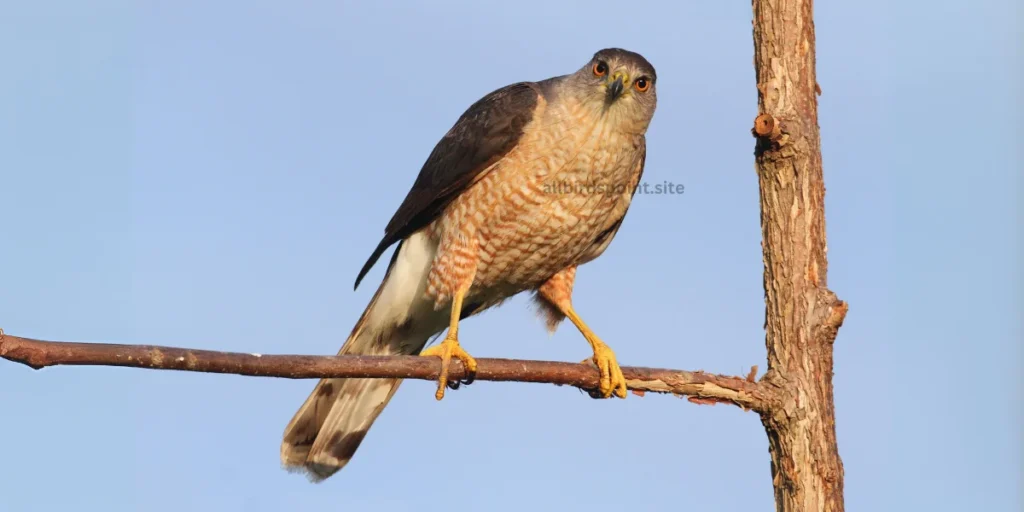
Appearance and Size
Cooper’s Hawks are slightly smaller than Red-tailed Hawks, with a wingspan of about 2.5 to 3.5 feet. Their plumage is generally grayish-blue on top with a lighter, streaked chest. They have short, rounded wings and long tails, which help them maneuver quickly through dense trees. Their eyes are bright red in adults, while younger hawks have yellow eyes.
Where They Live
Cooper’s Hawks prefer areas with lots of trees, such as forests and woodlands. However, they have adapted well to suburban areas where they can often be seen flying through backyards in search of prey. They build their nests high up in trees, where they are safe from predators.
Hunting and Diet
Cooper’s Hawks are excellent hunters and mainly prey on smaller birds, such as doves, robins, and pigeons. They also hunt small mammals like chipmunks and squirrels. These hawks rely on their speed and agility, often flying low and fast through trees to catch their prey by surprise. Their long tails help them make quick turns while chasing birds through thick vegetation.
Breeding and Nesting
During the breeding season, Cooper’s Hawks perform aerial displays to attract mates. Once a pair is formed, they build a nest high in a tree, using sticks and lining it with soft materials like bark. The female usually lays 3 to 5 eggs, and both parents share the responsibility of feeding and caring for the young. After about a month, the eggs hatch, and the chicks remain in the nest for around six weeks before they are ready to fly.
Cooper’s Hawks in Georgia
In Georgia, Cooper’s Hawks are often spotted near wooded areas or even in neighborhoods with tall trees. They are year-round residents, though some may migrate to warmer regions in winter. Their adaptability and hunting skills make them one of the most successful hawks in the region.
While not considered endangered, Cooper’s Hawks face some challenges, such as habitat loss and dangers posed by humans, like window strikes in urban areas. However, their ability to live in both wild and urban environments has allowed them to thrive in many parts of Georgia.
| Feature | Description |
|---|---|
| Size | Medium |
| Color | Bluish-gray back, pale underbelly |
| Habitat | Forests, wooded areas |
| Diet | Birds, small mammals |
| Lifespan | Up to 12 years |
| Behavior | Agile flier, often seen chasing birds |
Sharp-shinned Hawk: A Small but Fierce Predator in Georgia
The Sharp-shinned Hawk (Accipiter striatus) is the smallest hawk found in Georgia and throughout North America. Despite its size, this bird of prey is an agile and fierce hunter, known for its quick flights through forests and its remarkable ability to catch smaller birds in mid-air.
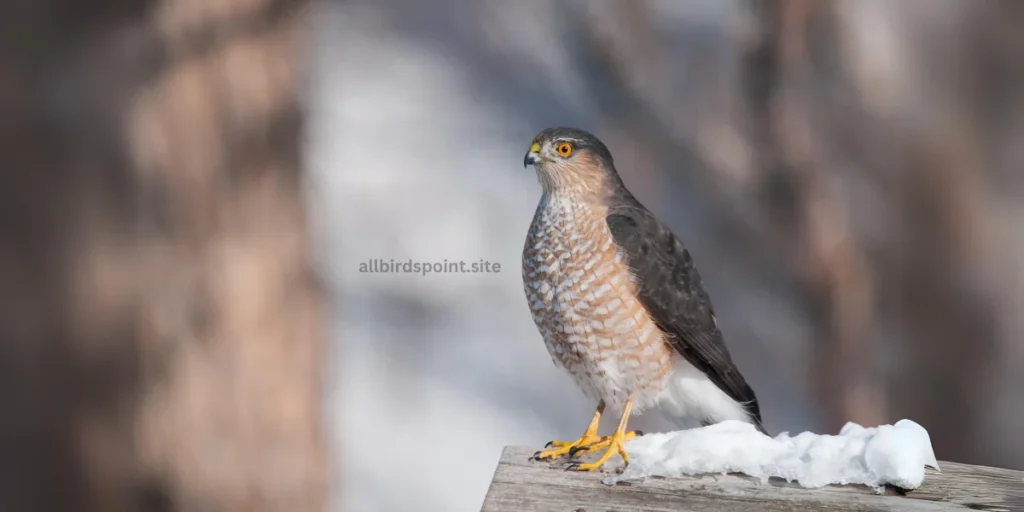
Appearance and Size
Sharp-shinned Hawks are petite, with a wingspan of about 1 to 2 feet and a weight of around 3 to 7 ounces. They have slate-gray feathers on their back, with a white, streaked underside. Like the Cooper’s Hawk, their wings are short and rounded, and their long tails are squared at the tip, helping them navigate through dense trees with great precision. Adults have striking red eyes, while juveniles have yellow eyes and more brownish coloring.
Where They Live
Sharp-shinned Hawks prefer forested areas, especially those with dense trees where they can hunt smaller birds. They can be found in Georgia year-round but are more commonly seen during migration in the fall and spring, as they move between breeding grounds in the north and warmer regions in the south. These hawks are also known to visit suburban areas, especially backyard bird feeders, where they can easily catch songbirds.
Hunting and Diet
Sharp-shinned Hawks are skilled bird hunters. Their primary diet consists of small birds, such as sparrows, finches, and warblers. They rely on their agility and speed, often darting through trees or bushes to surprise their prey. With their small size and quick reflexes, they are perfectly equipped to chase and catch birds in mid-flight, making them one of the most agile hunters in the raptor world. Occasionally, they may also hunt small mammals or insects.
Breeding and Nesting
During the breeding season, Sharp-shinned Hawks build their nests high up in trees, usually in dense forests. The nests are made from sticks and lined with softer materials like bark and leaves. The female typically lays 3 to 5 eggs, and both parents take turns incubating them. Once the eggs hatch, the parents continue to care for the young, feeding them until they are ready to leave the nest after about 4 to 5 weeks.
Sharp-shinned Hawks in Georgia
In Georgia, Sharp-shinned Hawks are more commonly seen during migration, although some stay in the state year-round. They are often spotted around wooded areas and even in residential neighborhoods where they can take advantage of bird feeders. Despite being small, these hawks are aggressive hunters and can often be seen chasing songbirds through the trees with impressive speed and agility.
Though their populations have seen some fluctuations, Sharp-shinned Hawks are not currently considered endangered. However, like many other birds of prey, they face challenges from habitat loss and dangers in urban environments, such as collisions with windows. Despite these threats, their ability to hunt and thrive in both wild and suburban areas ensures their presence in Georgia’s skies.
| Feature | Description |
|---|---|
| Size | Small |
| Color | Blue-gray back, orange barring on chest |
| Habitat | Dense forests, wooded areas |
| Diet | Small birds, insects |
| Lifespan | Up to 5 years |
| Behavior | Agile and quick, excellent maneuverability |
Broad-winged Hawk: A Seasonal Visitor to Georgia
The Broad-winged Hawk (Buteo platypterus) is a small but powerful raptor that makes its presence known in Georgia, especially during its seasonal migrations. These hawks are most famous for their incredible long-distance migrations, where thousands of them can be seen flying together in large groups called “kettles.” While they are not as commonly seen outside of migration periods, Broad-winged Hawks are a fascinating species that play an important role in Georgia’s ecosystem.
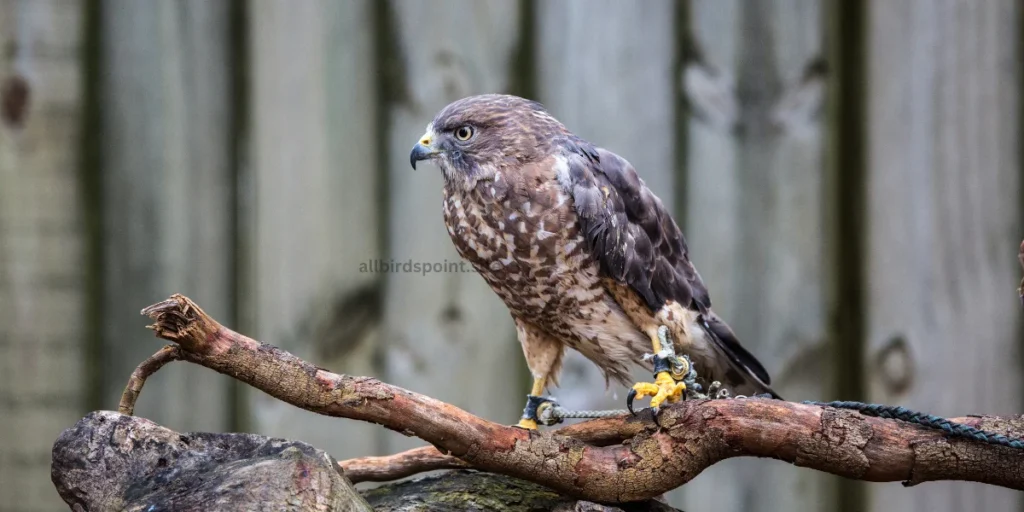
Appearance and Size
Broad-winged Hawks are small to medium-sized hawks, with a wingspan of about 3 feet and weighing between 9 to 20 ounces. They have broad, rounded wings and a short, squared tail with distinct black and white bands. Their plumage is generally brown on top, with lighter, barred undersides, and they have a sharp, hooked beak that is ideal for catching prey. Their smaller size and compact body make them highly maneuverable, especially when flying through forests.
Where They Live
Broad-winged Hawks are typically found in deciduous or mixed forests, where they can nest and hunt in the trees. They are not year-round residents in Georgia, only visiting during migration periods in the spring and fall. In the summer, they breed in forests across the eastern United States, and during the winter, they migrate to Central and South America. During migration, they are often spotted soaring high in the sky in large groups, making them more noticeable than during other times of the year.
Hunting and Diet
These hawks are skilled hunters, feeding primarily on small mammals like mice, voles, and squirrels. They also prey on amphibians, reptiles, and insects, such as frogs, snakes, and grasshoppers. Broad-winged Hawks hunt from a perch, waiting patiently until they spot their prey below. Once they’ve located their target, they dive quickly, grabbing it with their sharp talons. Their diet can vary depending on the season and availability of food, but they are versatile predators that can adapt to different environments.
Breeding and Nesting
During the breeding season, Broad-winged Hawks build their nests high up in trees, often reusing old nests from previous years. The nest is made of sticks and lined with softer materials like moss, leaves, and bark. The female usually lays 2 to 3 eggs, and both parents take turns incubating them for about a month. After hatching, the chicks stay in the nest for another 5 to 6 weeks before they are ready to fledge. Both parents continue to care for the young hawks even after they leave the nest.
Broad-winged Hawks in Georgia
In Georgia, Broad-winged Hawks are most noticeable during their migration periods, when they can be seen flying in large kettles as they head south for the winter or return in the spring. These mass migrations are a breathtaking sight for bird watchers, as thousands of hawks soar together in the skies. Outside of migration, these hawks are more secretive, often staying hidden in the forest canopy.
While they are not considered at risk, Broad-winged Hawks face some threats, particularly habitat loss due to deforestation. However, their wide range and large population have kept them relatively stable. Protecting their forest habitats and monitoring their migration routes will help ensure their continued survival in Georgia and beyond.
| Feature | Description |
|---|---|
| Size | Medium |
| Color | Brown back, light underbelly |
| Habitat | Forests, wooded swamps |
| Diet | Small mammals, amphibians, insects |
| Lifespan | Up to 12 years |
| Behavior | Migratory, often seen in large groups |
Red-shouldered Hawk: A Vibrant Raptor of Georgia’s Woodlands
The Red-shouldered Hawk (Buteo lineatus) is a striking bird of prey commonly found in the woodlands and wetlands of Georgia. Known for its rich reddish-brown coloring and piercing call, this medium-sized raptor is a year-round resident in many parts of the state, often spotted soaring through the skies or perched in tall trees near rivers and streams.

Appearance and Size
Red-shouldered Hawks are medium-sized, with a wingspan of about 3 to 4 feet and weighing between 1 to 2 pounds. Their most distinctive feature is the reddish-brown coloring on their chest and shoulders, which gives them their name. They also have dark, banded tails and wings with a checkered black and white pattern, making them easy to identify in flight. Their sharp eyes and hooked beak are typical of raptors, designed for hunting and tearing apart prey.
Where They Live
Red-shouldered Hawks are typically found in areas with dense woodlands and nearby water sources like rivers, swamps, and marshes. They prefer these habitats because the trees offer good nesting sites and the water attracts a wide range of prey. In Georgia, they can be seen year-round, particularly in forested areas or wetland regions. Their loud, repetitive call—a high-pitched “kee-aah”—is often heard echoing through the woods, signaling their presence long before they are seen.
Hunting and Diet
These hawks are skilled hunters, feeding on a variety of small animals. Their diet includes small mammals like mice, voles, and rabbits, as well as amphibians, reptiles, and even small birds. They are particularly fond of hunting near water, where they can catch frogs and snakes. Red-shouldered Hawks usually hunt from a perch, watching the ground carefully for any movement before swooping down to grab their prey with their sharp talons.
Breeding and Nesting
During the breeding season, Red-shouldered Hawks build their nests high up in tall trees, often near water. The nests are constructed from sticks and lined with softer materials like leaves and moss. The female lays between 2 to 4 eggs, which both parents take turns incubating. Once the eggs hatch, the young hawks remain in the nest for about 5 to 6 weeks before fledging. Even after they leave the nest, the young often stay near their parents for a while, continuing to learn hunting skills.
Red-shouldered Hawks in Georgia
Red-shouldered Hawks are common residents in Georgia, often seen in forested areas, particularly those near water. They are easy to recognize, not only by their striking appearance but also by their loud calls. These hawks play an important role in controlling the populations of small mammals and reptiles, helping to maintain balance in their ecosystems.
While Red-shouldered Hawks are not currently endangered, they do face threats from habitat loss due to deforestation and wetland destruction. Conservation efforts that protect their forested and wetland habitats are important to ensure that these beautiful birds continue to thrive in Georgia’s landscapes.
| Feature | Description |
|---|---|
| Size | Medium |
| Color | Reddish shoulders, barred wings and tail |
| Habitat | Wooded swamps, forests near water |
| Diet | Small mammals, birds, amphibians |
| Lifespan | Up to 15 years |
| Behavior | Loud call, often seen near water |
Northern Harrier: The “Gray Ghost” of Georgia’s Wetlands
The Northern Harrier (Circus hudsonius), also known as the “Gray Ghost” for its distinctive gray plumage, is a unique bird of prey often seen gliding over Georgia’s open fields, marshes, and wetlands. This medium-sized raptor is known for its low, graceful flight and owl-like facial structure, which sets it apart from other hawks in the region.
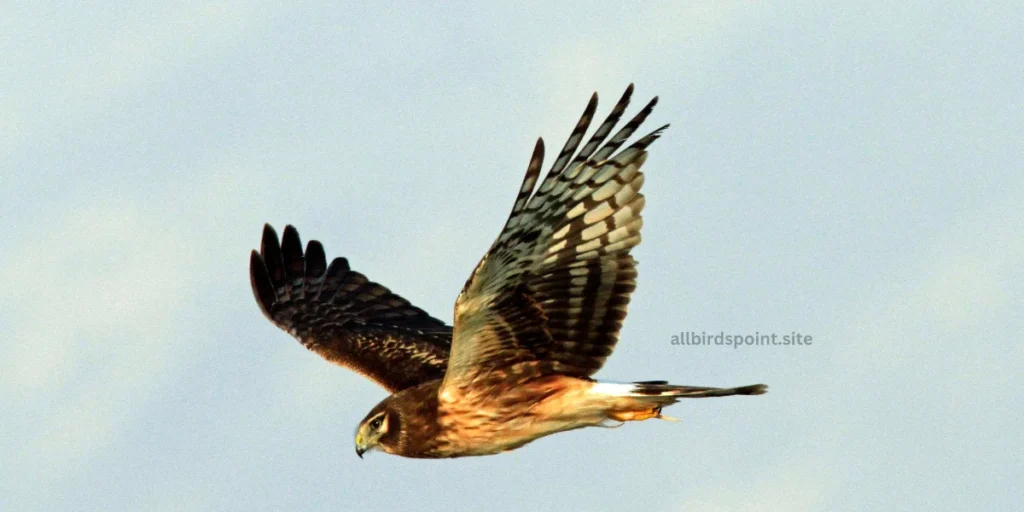
Appearance and Size
Northern Harriers are medium-sized hawks, with a wingspan of about 3.5 to 4 feet. Males are light gray, which gives them their ghostly nickname, while females and juveniles are brown with streaked undersides. One of the most distinctive features of this hawk is its facial disk, which resembles that of an owl and helps to enhance its hearing. This adaptation allows Northern Harriers to detect prey by sound as well as sight, making them highly effective hunters.
Where They Live
Northern Harriers prefer open habitats like marshes, grasslands, and wetlands, where they can easily search for prey. In Georgia, they are commonly seen in the winter months, as they migrate south from their northern breeding grounds in the United States and Canada. During this time, they can be spotted flying low over fields, often just a few feet above the ground, in search of food. Their graceful, slow flight is a characteristic sight in these open landscapes.
Hunting and Diet
The hunting style of the Northern Harrier is unique among hawks. Rather than relying solely on sight, they use both their sharp vision and excellent hearing to locate prey, which mainly consists of small mammals like voles, mice, and rabbits. They also feed on small birds and occasionally reptiles and amphibians. Northern Harriers are often seen flying low and methodically over fields and marshes, scanning the ground for movement before swooping down to catch their prey.
Breeding and Nesting
Unlike most other hawks, Northern Harriers nest on the ground, typically in dense vegetation like tall grasses or reeds. Their nests are made from sticks and lined with softer materials such as grass and leaves. During the breeding season, which occurs in their northern range, males may mate with multiple females, a behavior known as polygyny. The female usually lays 4 to 5 eggs, and both parents help care for the chicks once they hatch.
Northern Harriers in Georgia
In Georgia, Northern Harriers are primarily winter residents, arriving in the fall and staying until spring before migrating back north. They are most commonly found in open areas like wetlands, prairies, and agricultural fields. Their low, gliding flight and striking appearance make them a favorite among bird watchers during the colder months.
While Northern Harriers are not currently considered endangered, they face threats from habitat loss, particularly the draining of wetlands and conversion of grasslands to farmland. Protecting these open habitats is crucial for ensuring that Northern Harriers continue to thrive during their winter visits to Georgia.
| Feature | Description |
|---|---|
| Size | Medium |
| Color | Males are gray, females are brown |
| Habitat | Open fields, marshes |
| Diet | Small mammals, birds, reptiles |
| Lifespan | Up to 16 years |
| Behavior | Low gliding flight, white rump patch |
Swainson’s Hawk: A Long-Distance Migrant in Georgia
The Swainson’s Hawk (Buteo swainsoni) is a remarkable bird of prey known for its incredible migratory journey, traveling thousands of miles each year between its breeding grounds in North America and wintering grounds in South America. Although not as commonly seen in Georgia as some other hawks, Swainson’s Hawks can occasionally be spotted during migration, offering bird watchers a rare and exciting sight.
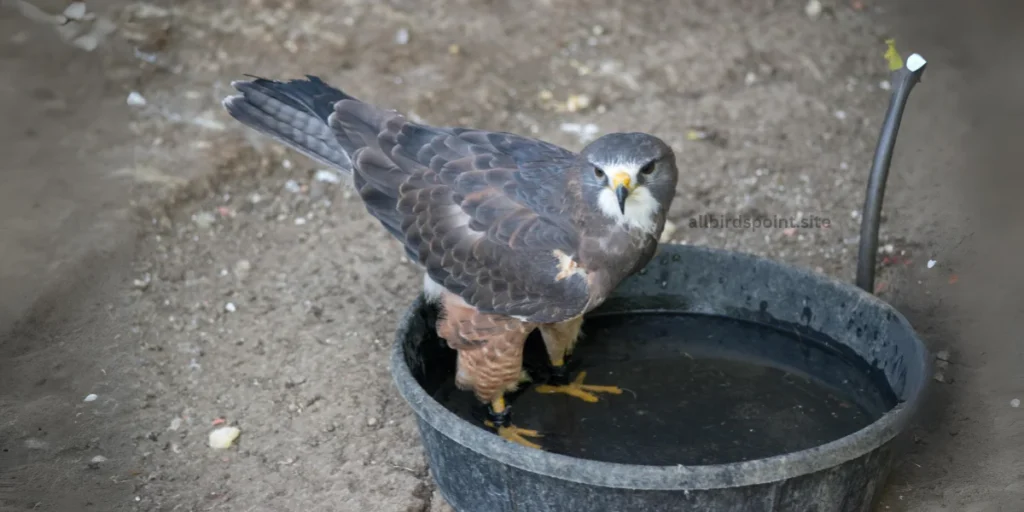
Appearance and Size
Swainson’s Hawks are medium to large hawks, with a wingspan of around 4 to 4.5 feet. They have long, broad wings and a relatively slender body, which makes them excellent long-distance fliers. Their plumage varies, with some individuals having a light morph featuring a white belly and dark brown chest, while others have a darker morph with more uniformly brown feathers. One of the key features of Swainson’s Hawks is their dark flight feathers, which contrast with their lighter underwings. Juvenile hawks have a more mottled appearance, with less distinct color patterns.
Where They Live
Swainson’s Hawks prefer open habitats such as grasslands, prairies, and agricultural fields. They are most commonly found in the western and central parts of North America during their breeding season, but they pass through various regions, including Georgia, during their migrations. In Georgia, they are seen mainly during the spring and fall, as they travel to and from their wintering grounds in Argentina. These long migrations, often spanning over 10,000 miles, are among the longest of any North American raptor.
Hunting and Diet
Swainson’s Hawks are highly adaptable hunters, feeding on a variety of prey depending on the season. During the breeding season, they mainly hunt small mammals like ground squirrels, mice, and rabbits. However, during migration and in their wintering grounds, they shift to a diet dominated by large insects, such as grasshoppers and dragonflies. This change in diet is unusual among hawks and highlights their ability to thrive in different environments. Swainson’s Hawks often hunt by soaring high above open fields, scanning the ground for prey, and then swooping down to catch it.
Breeding and Nesting
During the breeding season, Swainson’s Hawks build their nests in trees or on cliffs, often near open areas where they can hunt. The nests are made from sticks and lined with softer materials like grass. The female typically lays 2 to 3 eggs, and both parents take turns incubating them for about a month. Once the chicks hatch, the parents continue to care for them until they are ready to fledge, usually after 4 to 6 weeks.
Swainson’s Hawks in Georgia
While Swainson’s Hawks are not common residents of Georgia, they can be seen during migration, especially in open areas like fields or grasslands. Bird watchers may catch sight of these hawks soaring high in the sky, sometimes in large groups known as “kettles” as they prepare for their long journey south or return north. These migration sightings are often brief but exciting, as the hawks pass through on their way to or from their distant destinations.
Though their populations are stable, Swainson’s Hawks face threats from habitat loss, pesticide use, and environmental changes. Conservation efforts, particularly in their breeding and wintering grounds, are crucial to protecting this species and ensuring that their impressive migratory journey continues.
| Feature | Description |
|---|---|
| Size | Medium to large |
| Color | Dark chest, light underparts |
| Habitat | Grasslands, open fields |
| Diet | Insects, small mammals, birds |
| Lifespan | Up to 16 years |
| Behavior | Migratory, often seen in open areas |
Rough-legged Hawk: A Winter Visitor to Georgia’s Open Landscapes
The Rough-legged Hawk (Buteo lagopus) is a fascinating bird of prey that visits Georgia primarily during the winter months. Known for its striking plumage and ability to withstand cold climates, this hawk breeds in the Arctic tundra and migrates south to spend the winter in open areas across North America. Its distinctive appearance and graceful hunting style make it a favorite among bird watchers during the colder months.
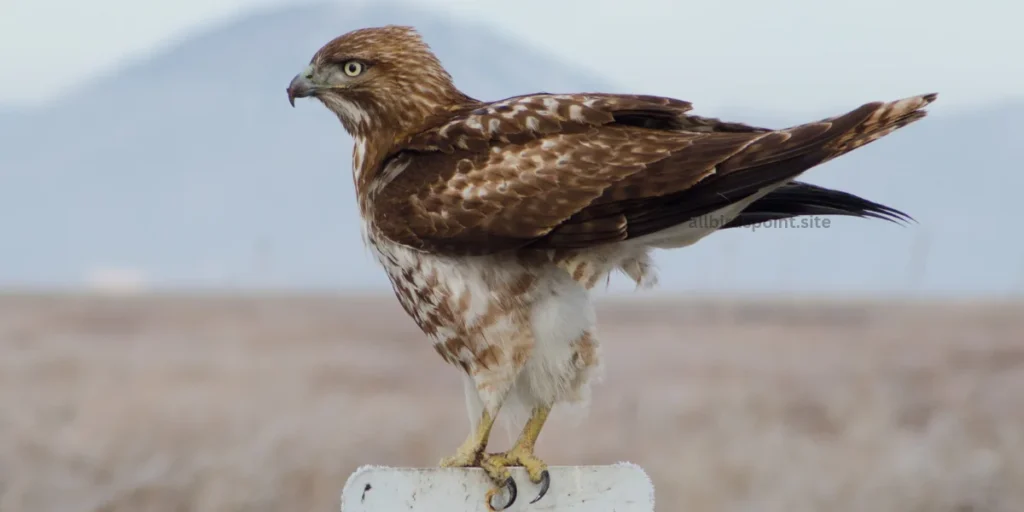
Appearance and Size
Rough-legged Hawks are large birds, with a wingspan of about 4.5 feet. They are named for the feathering that extends down their legs, which helps insulate them from the cold—an adaptation to the frigid environments in which they breed. These hawks have a light and dark morph, with the light morph being the most common. The light morphs feature a pale underside with dark patches at the wrists, while the dark morphs are mostly brown with less contrasting patterns. Their tails are typically white at the base with a dark band near the tip, which is a key feature in identifying them.
Where They Live
In Georgia, Rough-legged Hawks are winter visitors, most often seen in open habitats such as grasslands, agricultural fields, and marshes. These areas provide the space they need to hunt for small mammals, their primary food source during winter. The hawks migrate from their breeding grounds in the Arctic tundra, traveling south as far as the northern parts of Georgia to escape the harsh winter conditions.
Hunting and Diet
Rough-legged Hawks are adept hunters, primarily feeding on small mammals like voles, mice, and lemmings. They use their excellent vision to spot prey from high in the air or from a perch, then swoop down to capture it with their strong talons. These hawks often hover in the air, a behavior known as “kiting,” while searching for prey below. This hovering technique is rare among larger raptors and helps them hunt in open areas where prey can be difficult to spot.
Breeding and Nesting
Rough-legged Hawks breed in the Arctic, where they nest on cliffs or in trees if available. Their nests are large structures made from sticks and lined with soft materials such as moss and feathers. The breeding season in the Arctic is short, and the female lays 2 to 7 eggs, depending on food availability. Both parents take turns incubating the eggs and caring for the young. Once the chicks hatch, they grow quickly to take advantage of the short summer season before migrating south.
Rough-legged Hawks in Georgia
In Georgia, Rough-legged Hawks are most commonly seen in the winter, often in open fields or marshes where they hunt for small mammals. Their distinctive hovering behavior and striking plumage make them relatively easy to identify compared to other hawks. While they are not permanent residents of the state, their presence during the colder months adds to the diversity of Georgia’s bird life.
Although Rough-legged Hawks are not considered threatened, they do face challenges from habitat loss and changes in climate that could impact their breeding and wintering grounds. Protecting the open landscapes they rely on during their winter migration is important for ensuring the continued health of their populations.
| Feature | Description |
|---|---|
| Size | Medium |
| Color | Light head and tail, dark belly |
| Habitat | Open fields, marshes |
| Diet | Small mammals, birds |
| Lifespan | Up to 18 years |
| Behavior | Often seen in winter, prefers open areas |
Ferruginous Hawk: A Rare and Powerful Hunter in Georgia
The Ferruginous Hawk (Buteo regalis) is a large and majestic bird of prey, known for its strength and striking appearance. Though not commonly seen in Georgia, this hawk is native to the western plains of North America and is occasionally spotted in the state during migration or in open habitats. The Ferruginous Hawk is the largest of the buteo hawks and is recognized for its rust-colored (ferruginous) plumage and powerful hunting skills.

Appearance and Size
Ferruginous Hawks are impressive in size, with a wingspan that can reach up to 5 feet and a weight of 2 to 4.5 pounds. They are easily recognized by their reddish-brown plumage, particularly on their back, shoulders, and legs. Their underparts are typically white, with some dark streaks or spots. These hawks come in both light and dark morphs, but the light morph is more common. In addition to their large size, they have broad wings and a wide tail, which helps them soar effortlessly over open landscapes. Their legs are feathered all the way down to their talons, much like the Rough-legged Hawk, providing extra warmth in cold climates.
Where They Live
Ferruginous Hawks are typically found in open areas such as grasslands, prairies, and deserts, where they have plenty of space to hunt. While they primarily breed and live in the western United States and Canada, they are rare visitors to Georgia, usually during migration or in search of new hunting grounds. When they are spotted in Georgia, it is often in open fields, agricultural areas, or other expansive environments that resemble their native habitats.
Hunting and Diet
Ferruginous Hawks are powerful hunters, primarily feeding on small to medium-sized mammals like rabbits, ground squirrels, and prairie dogs. They also prey on birds, reptiles, and large insects when available. These hawks typically hunt from a perch or soar high in the air, scanning the ground for movement before diving down to capture their prey. Their large talons and strong beak make them particularly effective at taking down larger prey compared to other hawks. Unlike some raptors that hunt by surprise, Ferruginous Hawks often fly at low altitudes, watching carefully for prey before swooping in.
Breeding and Nesting
Ferruginous Hawks build large nests made of sticks, often placed on cliffs, rocky outcrops, or large trees. In areas without natural structures, they may even build their nests on the ground or on man-made structures like utility poles. The female lays 2 to 4 eggs, and both parents take part in incubating and feeding the chicks. Ferruginous Hawks are known for their strong parental care, with the chicks remaining in the nest for about 5 to 7 weeks before fledging.
Ferruginous Hawks in Georgia
While Ferruginous Hawks are not commonly seen in Georgia, bird watchers might occasionally spot them during migration in open fields or along rural areas that provide plenty of hunting opportunities. Their large size, reddish plumage, and powerful hunting techniques make them an exciting and rare sight in the state.
Although Ferruginous Hawks are not considered endangered, they do face threats from habitat loss, particularly the conversion of grasslands to farmland or urban areas. Conservation efforts aimed at preserving their natural habitats in the western plains are crucial to ensuring the long-term survival of this impressive raptor.
| Feature | Description |
|---|---|
| Size | Large |
| Color | Pale with rust-colored feathers |
| Habitat | Grasslands, open areas |
| Diet | Small mammals, birds |
| Lifespan | Up to 20 years |
| Behavior | Powerful hunter, prefers open habitats |
Zone-tailed Hawk: A Master of Disguise in Georgia’s Skies
The Zone-tailed Hawk (Buteo albonotatus) is a fascinating bird of prey that is known for its remarkable ability to mimic the appearance and flight of vultures, allowing it to approach its prey unnoticed. While the Zone-tailed Hawk is more commonly found in the southwestern United States, sightings of this unique hawk in Georgia are rare but possible during migration.
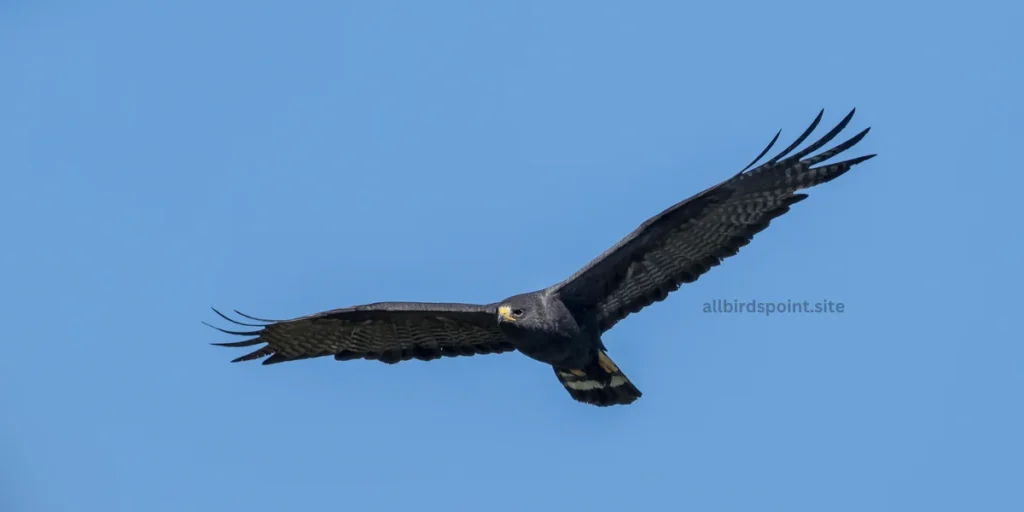
Appearance and Size
Zone-tailed Hawks are medium-sized raptors with a wingspan of about 4 feet and a weight between 1 to 2 pounds. They have predominantly dark plumage, with blackish-brown feathers covering most of their bodies, which helps them blend in with vultures when soaring. One of the key features of this hawk is the white bands, or “zones,” on its tail, which give the bird its name. When in flight, these white bands are often visible against the darker tail. Juveniles are paler and have more streaked underparts than adults.
Where They Live
Zone-tailed Hawks are primarily found in the deserts, canyons, and forested mountain areas of the southwestern U.S. and Central America. However, during migration, they may travel into other regions, and very rare sightings have been reported in the southeastern U.S., including Georgia. They prefer habitats with open areas for hunting and wooded areas for nesting, often near water sources. In Georgia, they might be spotted in open fields or near rivers, but these sightings are uncommon.
Hunting and Diet
The Zone-tailed Hawk is a skilled hunter with a unique strategy. It mimics the flight pattern of turkey vultures, soaring high in the sky with its wings held in a slight V-shape, similar to vultures. This resemblance allows the hawk to blend in with vultures, which are not seen as a threat by other animals. As a result, the Zone-tailed Hawk can get closer to its prey before attacking.
Their diet consists mainly of small mammals, birds, reptiles, and even large insects. They often hunt by flying low over the ground, using surprise to catch their prey unaware. Their strong talons and sharp beaks make them effective predators, capable of taking down a wide variety of prey.
Breeding and Nesting
Zone-tailed Hawks typically nest in trees, cliffs, or rock ledges, often near water. Their nests are made from sticks and lined with softer materials such as leaves and bark. The female usually lays 1 to 3 eggs, and both parents take part in incubating the eggs and feeding the chicks. The young hawks remain in the nest for about 6 weeks before they are ready to fledge, and even after leaving the nest, they may stay with their parents for some time as they learn to hunt.
Zone-tailed Hawks in Georgia
While Zone-tailed Hawks are not common in Georgia, rare sightings may occur during migration. Bird watchers should keep an eye out for a hawk that resembles a vulture in flight but has the telltale white bands on its tail. Spotting one of these hawks in Georgia would be a special treat, as their presence in the state is uncommon but possible.
Although Zone-tailed Hawks are not considered threatened, habitat loss and environmental changes in their native range can impact their populations. Protecting the open areas and forested habitats they depend on is essential for ensuring their survival.
| Feature | Description |
|---|---|
| Size | Medium |
| Color | Black with white tail bands |
| Habitat | Wooded canyons, mountainous areas |
| Diet | Small mammals, birds |
| Lifespan | Up to 14 years |
| Behavior | Rare, mimics vultures to hunt |
Conclusion
Hawks are amazing birds of prey that contribute to Georgia’s rich wildlife. Each type of hawk has its own special features and behaviors, making birdwatching fun and interesting. By learning about the different hawks in Georgia, you can appreciate their role in nature and the beauty they add to the sky. So, next time you’re outdoors in Georgia, keep an eye out for these impressive birds!
FAQs
1. What is the most common hawk in Georgia?
The Red-tailed Hawk is the most common hawk in Georgia. It is easily recognizable by its red tail and is often seen in open areas and along highways.
2. Where can I see hawks in Georgia?
Hawks can be seen in various habitats across Georgia, including forests, open fields, wetlands, and even suburban areas. Look for them soaring in the sky or perched on high spots like trees and poles.
3. Are hawks dangerous to humans?
Hawks are not typically dangerous to humans. They may become defensive if their nests are threatened, but they generally avoid human interaction.
4. What do hawks eat?
Hawks primarily eat small mammals, birds, reptiles, and insects. Their diet varies depending on the species and the availability of prey in their habitat.
5. How can I identify a hawk?
Hawks can be identified by their size, shape, flight pattern, and markings. Observing their tail and wing shapes, as well as their behavior, can help in identifying different species.
6. Do hawks migrate?
Some hawk species, such as the Broad-winged Hawk and Swainson’s Hawk, migrate long distances. Others, like the Red-tailed Hawk, may migrate short distances or remain in the same area year-round.
7. How long do hawks live?
The lifespan of hawks varies by species. On average, hawks can live between 5 to 20 years in the wild. Factors such as predation, availability of food, and human impact can influence their lifespan.
8. What time of year are hawks most active?
Hawks are generally active year-round, but migration periods in spring and fall can offer the best opportunities to see large numbers of certain species, like the Broad-winged Hawk.
9. Can hawks see well at night?
Hawks have excellent daytime vision, which is crucial for hunting, but they do not see well at night. They rely on their keen eyesight during the day to spot prey from great distances.
10. Are hawks protected in Georgia?
Yes, hawks are protected under the Migratory Bird Treaty Act. It is illegal to harm, capture, or kill hawks without proper permits. Conservation efforts help ensure their populations remain healthy.
